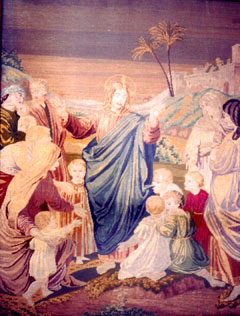Needlework
Fine Arts Education was a Key Component Within SSND

Tapestry (needlework) done by Mother Caroline Friess
Mother Theresa was aware of the importance of needlework in educating young women and children. It was and still is an important part of German education. She directed that needlework be taught ten hours a week. She understood the importance of needlework in helping children learn to focus their attention. She had witnessed the discipline of following directions, of struggling to learn eye-hand motor coordination, resulting in increased self-esteem for children. She was carrying on her German culture's appreciation of the role of needlework in educating the whole child. Reflect on her curriculum in the first school at Stadtamhof. She needed strong silk thread for sewing tapestries and began raising prize silkworms for this purpose. Note the award she acknowledged from the Bavarian government on raising silkworms.
Mother Caroline continued this German/European tradition of seeing needlework as a vital part of education. As a child she was taught to sew by her grandmother. Imagine a child of seven learning the discipline of stitching and finding self-confidence growing along with her skills.
Her skill in needlework is evident in the tapestry hanging at Elm Grove (pictured). One can understand her dismay at meeting American children with so little eagerness to learn needlework. Check out her first impressions of American children, noting her dismay at their "needlework."
In the nineteenth century, School Sisters of Notre Dame were noted for their outstanding needlework students. Consider the work of young girls at St. Joseph's school which has been displayed in museums.
Consider the role of needlework and the vow of poverty as clarified in the Holy Rule of 1924. The Fine Arts were especially important in the lives and ministry of the School Sisters of Notre Dame.
Several German sisters have gifted the American missions with their skill as certified needlework teachers. Reflect on the stories of five needlework teachers whose gifts are still cherished in various Units of the congregation. View the portfolio of Sister Johanna Dick as an example of the quality work expected of German needlework teachers.
In more recent times the opportunity to learn sewing and needlework has given hope to those devastated by Hurricane Mitch in Honduras as well as the women in Paraguay. Follow the journey of sewing machines coming to Sulaco, Honduras and reflect on the role of sewing among the women, and a few men, in Paraguay.
The Liturgical Fabric Arts Department of St. Louis continues a tradition of needlework within the School Sisters of Notre Dame. View the tablecloth and napkins that accompany "Sturdy Roots," and consider living the motto of the School Sisters of Notre Dame. Facilitator directions are available.
To learn more about Needlework, explore the following options.
Josepha Learns to SewNeedlework in AmericaStudents' NeedleworkHoly Rule of 1924German TeachersMissionToday Facilitator Directions
Return to Needlework